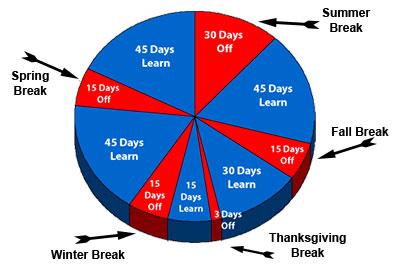Year-Round Schools: 5 Things To Know
Schools that employ a year-round or balanced calendar hope to limit learning loss and provide more resources and one-on-one attention for students.

Year-round school can sound intimating. Those unfamiliar with the concept might envision canceled summer vacations and math tests instead of beach days. However, in reality, year-round schools don’t have students attend schools on more days, these schools simply operate on a different calendar with more frequent but shorter vacation breaks. In this way, year-round schools, or schools with a balanced calendar, hope to avoid the negative effects of the summer slide and provide students more opportunities to catch up to their classmates if they fall behind.
Though the concept is often debated, hundreds of schools and districts throughout the U.S. have implemented a year-round school or balanced calendar. Enthusiasts cite research suggesting benefits for both students and staff. In Washington state, the Office of Superintendent of Public Instruction recently launched the Balanced Calendar Initiative, which offers districts grant funding to explore flexible scheduling.
Discussing some of the common questions and misconceptions that arise around the concept of year-round school or balanced calendars is important when considering implementing the approach.
1. Year-Round Schools Don’t Require More Days in School or Ruin Summer
Like other students, those enrolled in year-round schools only attend the number of school days required in their state, which is generally 180 days of school. The time off is just structured differently. “Over the years, we've moved away from what is called the year-round calendar, because when you say, ‘year-round,’ parents and stakeholders believe you're going to school 300-plus days a year, and that's not the case,” says David G. Hornak, Ed.D., executive director, of the National Association for Year-Round Education (NAYRE).
Instead of year-round school, the preferred term is a balanced calendar as it more accurately describes how these schools operate. “Balanced calendar schools will generally start in early August, they'll take a little time off at Labor Day, they'll take a two-week October break, one week at Thanksgiving, and the typical two weeks at the holidays,” says Hornak, who is also Superintendent of Holt Public Schools in Michigan. “They’ll take one week off in February, a two-week spring break, and one week off at Memorial Day, and then they end late June.”
There is variation among balanced or year-round schools in this calendar, but it generally follows that pattern. The whole point is limiting the length of any single break, so in Michigan, for instance, schools are not considered year-round if they have any breaks lasting more than six weeks.
As for the summer vacations that are a fond part of most people’s memories, they’re not entirely eliminated. “It’s a common misconception that there is no summer vacation, you still get summer vacation, four to six weeks,” says Tracy Daniel-Hardy, Ph.D., Director of Technology for Gulfport School District in Mississippi, which recently implemented a year-round balanced calendar.
Tools and ideas to transform education. Sign up below.

2. Year-Round Schools May Decrease Summer Learning Loss and Have Other Benefits
Year-round schools and districts aim to reduce the summer slide and help combat learning loss. One tool for doing this is eliminating the summer vacation gap in learning. Another way is by affording regular chances for students who are behind to catch up. During the breaks in school, year-round schools offer what is called “intersession.” This is an opportunity for students to get tutoring and learn skills they may lack, it also allows more advanced students to explore certain topics more deeply. “Some kids need to have learning extensions, and we give them those during intersession,” Hornak says. “Other kids need to be remediated and our go-to move in the past has been, we'll make it up in the summer. Can you imagine if someone's starting to fall behind in October, November, December, and we say, 'Well, guess what, you have to struggle another five months before we can help you.' That's just inhumane.”
3. Teachers are More Okay With Year-Round Schools Than You Might Expect
When Gulfport School District began considering a year-round school, in addition to student-centered benefits around retention and learning, they also hoped it would help reduce teacher burnout, Daniel-Hardy says.
Teachers who get summer jobs sometimes worry that a year-round calendar will take income away by preventing them from obtaining summer jobs, but they have the opportunity to earn extra money by working through intersession. “They can actually supplement their income right out of their own classroom,” Hornak says.
With a flexible calendar, teachers tend to take fewer personal days during the school year because they schedule dental appointments and similar outings for the various breaks the flexible calendar affords. This limits reliance on substitute teachers, Hornak says.
4. You Can Still Do Sports But There Are Unexpected Challenges to Year-Round School
A common concern is the impact on sports seasons, but year-round schools are still able to support sports schedules. Students just may have games during intersession. However, sports are not the only non-academic concern around year-round schools. Daycare needs and the local economy also need to be considered.
Because Gulfport is a coastal area with lots of tourism, there were considerations around a year-round calendar that other districts might not have.
“We wanted to get the business and those involved in tourism involved in the conversation as well,” Daniel-Hardy says. It was only after addressing community concerns and hosting an open dialogue with stakeholders that the district launched its year-round calendar.
In Hornak’s district, only two schools operate on a true year-round calendar, other schools use a modified hybrid calendar. This is because the district’s infrastructure can’t support extended summer learning at some schools. “Lack of air conditioning is a real issue here,” Hornak says.
5. Districts Considering Year-Round Schools Should Talk to Others Who Have Done it
School leaders considering a year-round or balanced calendar should consult community leaders as well as staff from the entire district. “It’s really important to get input from all of your stakeholders,” Daniel-Hardy says. “Not just teachers and administrators, but also the chief maintenance officer, finance department, the coaches, all of them, because what they do is directly impacted.”
You’ll also want to speak with others who have implemented a similar calendar. “There are a lot of reasons why families or community members come forward to say this won't work. We don't want this,’ and if there’s a question a superintendent or a leadership team is not able to answer that tends to undermine the confidence from the community,” Hornak says. “So we have found when you partner with a local expert, someone who's lived the balanced calendar, or someone from my office, we're able to navigate those questions, and it allows the local leader to be a listener.”
- Extended Learning Time: 5 Things to Consider
- Educators Moving Away from Seat Time for Mastery-Based Education
To share your feedback and ideas on this article, consider joining our Tech & Learning online community.
Erik Ofgang is a Tech & Learning contributor. A journalist, author and educator, his work has appeared in The New York Times, the Washington Post, the Smithsonian, The Atlantic, and Associated Press. He currently teaches at Western Connecticut State University’s MFA program. While a staff writer at Connecticut Magazine he won a Society of Professional Journalism Award for his education reporting. He is interested in how humans learn and how technology can make that more effective.

